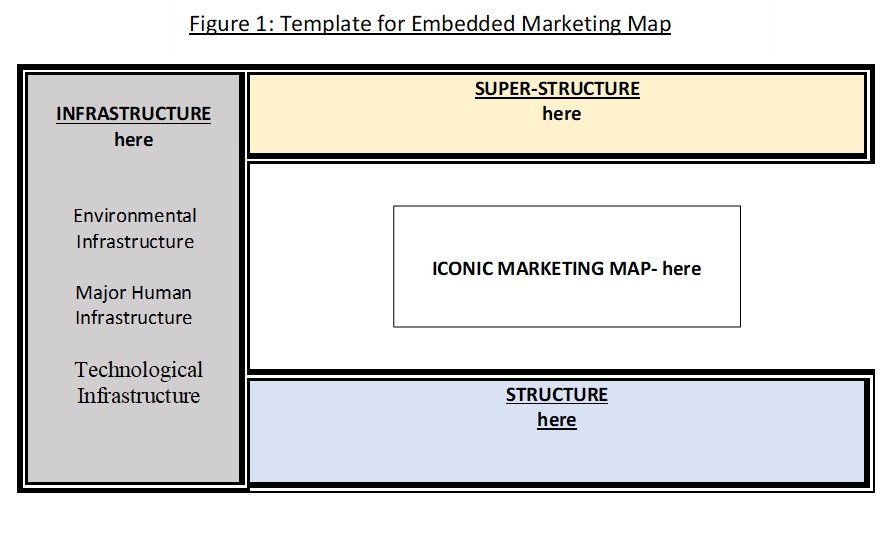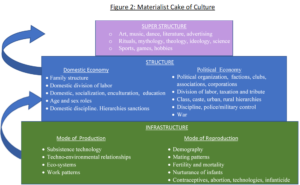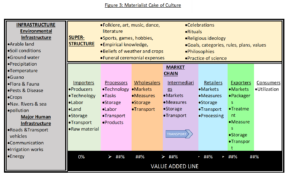A value chain can include a limitless number of links to examine and follow and is sometimes confusing for researchers. Thus, drawing on the Cultural Materialist Research Strategy (see Harris 1979) we developed the following technique to rapidly summarize, explain and make recommendations for value chain research and presentation.
Value Chain Mapping Strategy Summary Guide

The technique begins by providing a brief written description of production, processing and marketing of the item. Specific points covered in the description are also transport, who the consumers are, and sexual and age division of labor and ownership. The research then develops graphic maps of these processes, including production maps that depict the process of production, indicating gender roles, labor process, technologies, and relevant tenure (ownership). Then a map of the process and market chain is built. This latter map includes graphic depiction of type of measurement (quantity, volume or weight), gender and status of the person who markets the item, transport, and the market venues. A summary of the topics included in the value chain include the following:

A final map includes both production and processing as well as identification of points most opportune for making interventions to strengthen the market chain. Very importantly, the final map is embedded in a description of the relevant Infrastructure, Social Structure, and Super Structure factors. To elaborate, these three categories are defined as follows,
Infrastructure
- natural environment: sea, forests, rivers, savannah, mines, foliage, fishing groungs
- human infrastructure: demography, roads, transport, communication systems, technology
- Defined by specification of the dimensions of the resources, such as amount of coast, kilometers of road, quality.
Social Structure
- Economic systems: Markets, stores, trade centers
- Institutions: police, schools, associations, NGOs, ministries…
- Defined by identification/existence of institution and measured in strength on a scale of 1 to 5, one being weakest and 5 strongest (indicated by number of asterisks, “*”.
Super Structure
- Ideas, religions, taboos, celebrations
- Defined by identification/existence and in the case of stringent religious taboos or institutions, measured in strength on a scale of 1 to 5, one being weakest and 5 strongest (indicated by number of asterisks, “*”.
The Infrastructure, Structure and Superstructure are the constraints of the chain. They define what interventions to the chain are practical within the context of what is available in the natural and social environments and the cultural beliefs and practices of the people of the Grand Anse. It may be that a development intervention can overcome a limitation in one or several of these spheres, but the current limitations must be identified and understood. The idea is not to exhaustively explain each category, but rather to catalogue the existence or absence of those constraints of opportunities that are relevant. In this way, the strategy narrows the focus of discussion to a framework of practical options, thereby helping to catalyze the decision-making process regarding development interventions.
Theoretical Assumptions Underlying Value Chains Guide
Theoretically, the maps described above are framed in a materialist perspective. The underlying assumption is that the most important features of a Mode of Production that researchers should understand and focus on are factual and concrete aspects of the infrastructure and structure. Thus, in making assumptions about causation, understanding how a market chain functions, and approaching the decision-making process regarding appropriate aid- interventions, priority is given first to environmental constraints and opportunities, including demographics and availability of raw materials. Priority is given next to economic and technological constraints and opportunities. Priority is then given to social structural constraints and opportunities. And ultimately, consideration is given to cultural, ideological and religious constraints and opportunities. None of this is to say that ideas and states of mind are not of tantamount importance. The point is simply that in understand what interventions will ultimately be most practical, aid practitioners must understand what already exists first in terms of environmental constraints, second in terms of social-structural constraints, and only then in terms of ideational constraints.









